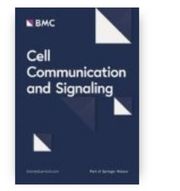Sex hormone-binding globulin (SHBG) mitigates ER stress and improves viability and insulin sensitivity in adipose-derived mesenchymal stem cells (ASC) of equine metabolic syndrome (EMS)-affected horses
Nabila Bourebaba; Mateusz Sikora; Badr Saif Qasem; Lynda Bourebaba; Krzysztof Marycz
Cell Communication and Signaling
Ministerial score = 140.0
Journal Impact Factor (2023) = 8.4 (Q1)
 Background: Equine metabolic syndrome (EMS), which encompasses insulin resistance, low-grade inflammation and predisposition to laminitis is a critical endocrine disorder among the most prevalent conditions affecting horses from different breeds. According to the most recent research, low human sex hormone-binding globulin (SHBG) serum levels correlate with an increased risk of obesity, insulin resistance and diabetes, and may contribute to overall metabolic dysregulations. This study aimed to test whether exogenous SHBG could protect EMS affected adipose-derived stromal stem cells (EqASCEMS) from apoptosis, oxidative stress, ER stress and thus improve insulin sensitivity. Methods: EqASCEMS wells were treated with two different concentrations (50 and 100 nM) of exogenous SHBG, whose biocompatibility was tested after 24, 48 and 72 h of incubation. Several parameters including cell viability, apoptosis, cell cycle, reactive oxygen species levels, ER stress, Pi3K/MAPK activation and insulin transducers expression were analysed. Results: Obtained data demonstrated that exogenous SHBG treatment significantly promoted ASCs cells proliferation, cell cycle and survival with reduced expression of p53 and p21 pro-apoptotic mediators. Furthermore, SHBG alleviated the oxidative stress caused by EMS and reduced the overaccumulation of intracellular ROS, by reducing ROS + cell percentage and regulating gene expression of endogenous antioxidant enzymes (Sod 1, Cat, GPx), SHBG treatment exhibited antioxidant activity by modulating total nitric oxide (NO) levels in EMS cells as well. SHBG treatment dampened the activation of ER stress sensors and effectors in EqASCEMS cells via the upregulation of MiR-7a-5p, the decrease in the expression levels of ATF-6, CHOP and eiF2A and the restoration of PDIA3 chaperone protein levels. As a consequence, SHBG application substantially improved insulin sensitivity through the modulation of Pi3K/Akt/Glut4 insulin signalling cascades. Conclusion: Our results suggest that the SHBG is endowed with crucial beneficial effects on ASCs metabolic activities and could serve as a valuable therapeutic target for the development of efficient EMS treatment protocols.
Background: Equine metabolic syndrome (EMS), which encompasses insulin resistance, low-grade inflammation and predisposition to laminitis is a critical endocrine disorder among the most prevalent conditions affecting horses from different breeds. According to the most recent research, low human sex hormone-binding globulin (SHBG) serum levels correlate with an increased risk of obesity, insulin resistance and diabetes, and may contribute to overall metabolic dysregulations. This study aimed to test whether exogenous SHBG could protect EMS affected adipose-derived stromal stem cells (EqASCEMS) from apoptosis, oxidative stress, ER stress and thus improve insulin sensitivity. Methods: EqASCEMS wells were treated with two different concentrations (50 and 100 nM) of exogenous SHBG, whose biocompatibility was tested after 24, 48 and 72 h of incubation. Several parameters including cell viability, apoptosis, cell cycle, reactive oxygen species levels, ER stress, Pi3K/MAPK activation and insulin transducers expression were analysed. Results: Obtained data demonstrated that exogenous SHBG treatment significantly promoted ASCs cells proliferation, cell cycle and survival with reduced expression of p53 and p21 pro-apoptotic mediators. Furthermore, SHBG alleviated the oxidative stress caused by EMS and reduced the overaccumulation of intracellular ROS, by reducing ROS + cell percentage and regulating gene expression of endogenous antioxidant enzymes (Sod 1, Cat, GPx), SHBG treatment exhibited antioxidant activity by modulating total nitric oxide (NO) levels in EMS cells as well. SHBG treatment dampened the activation of ER stress sensors and effectors in EqASCEMS cells via the upregulation of MiR-7a-5p, the decrease in the expression levels of ATF-6, CHOP and eiF2A and the restoration of PDIA3 chaperone protein levels. As a consequence, SHBG application substantially improved insulin sensitivity through the modulation of Pi3K/Akt/Glut4 insulin signalling cascades. Conclusion: Our results suggest that the SHBG is endowed with crucial beneficial effects on ASCs metabolic activities and could serve as a valuable therapeutic target for the development of efficient EMS treatment protocols.
DOI:10.1186/s12964-023-01254-6









